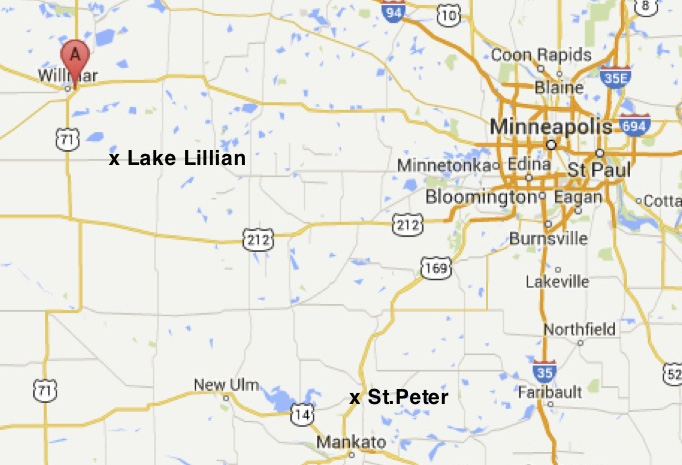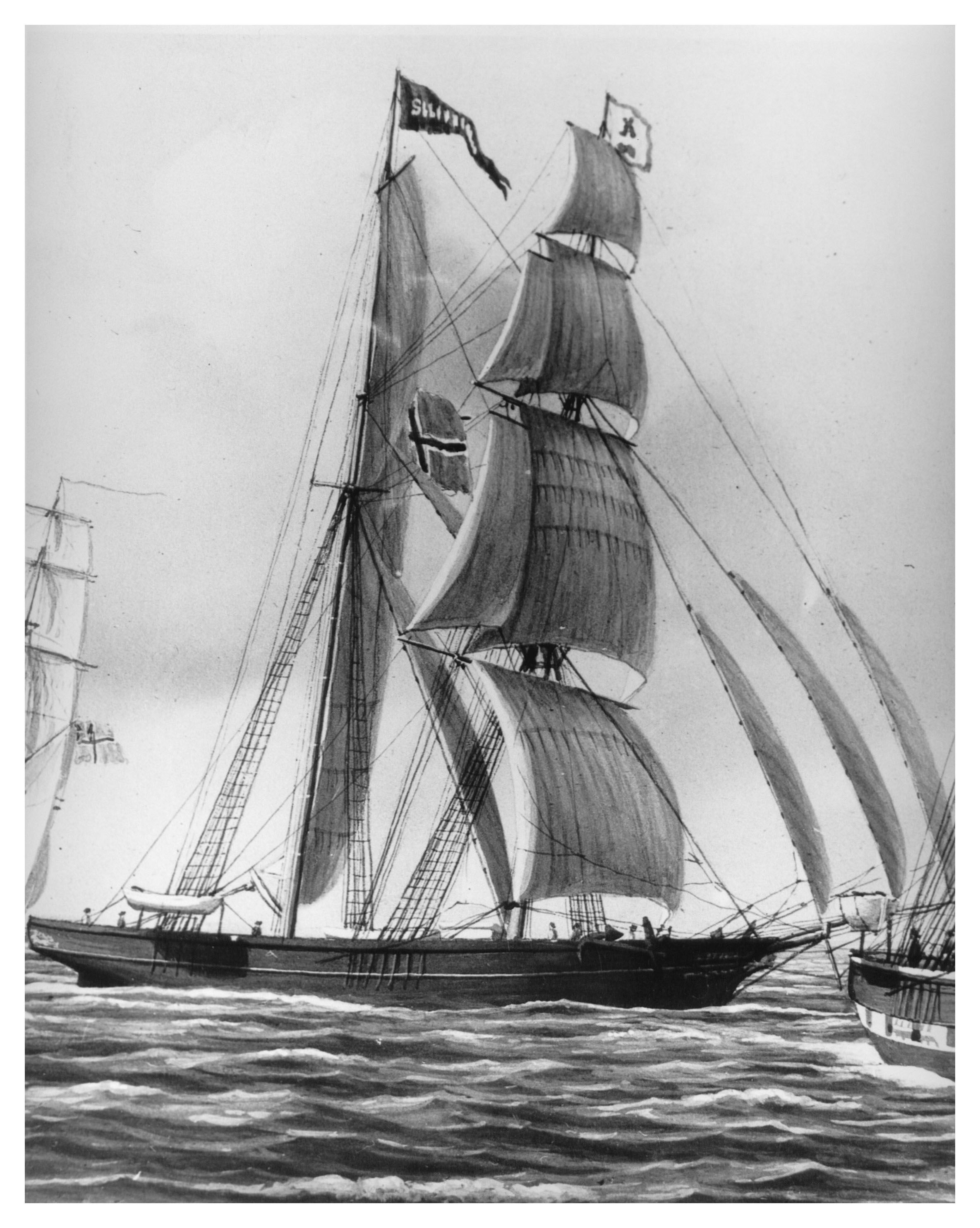
The article appeared in the yearbook for balsfjord and Malangen 2014. Here translated to English.
(Translated by Gordon J. Trangen and edited by LaVonne Bomsta Hookom and Gary Gauer.)
posted November 2016
On June 3, 1864, a group of families from the Troms district of Northern Norway arrived at a small lake in Minnesota. Here they would build their home in the New World. The lake is called Lake Lillian, and is in Kandiyohi County, 130km (80.77 miles) west of Minneapolis, Minnesota. This was the beginning of a community, that for several generations would have great significance for immigrants from both the Balsfjord and Karlsøy districts of Troms.
The leader of this group was Johan Andreas Johannessen Bomstad. Some years earlier in Balsfjord, he had founded the "Free Apostolic Congregation." In 1862 a group of religious dissenters within this congregation led by Bomstad, decided to emigrate to America. The expedition travelled by ship to Bergen where they boarded the brig "Sleipner" under the command of Captain Hans T. Waage to cross the Atlantic. The ship would be the first to sail from a Scandinavian or European port all the way to Chicago. There was great interest in this voyage, as it was hoped it would establish a permanent route.

Maleri av «Sleipner»
The "Sleipner" sailed from Bergen May 21, 1862. It arrived in Quebec on July 6, and then reached Chicago a few weeks later on August 2. The voyage from Bergen had taken 71 days. Forty passengers disembarked in Detroit, but around sixty five made the entire trip. No passenger list remains, but "Nordlendinger" (northern Norwegians) must have constituted the lion's share of these passengers.

![]()
If we examine dissenter documents, passport records, and family histories, we can establish that Bomstad's group consisted of approximately fifty people, men, women and children from Balsfjord, Tromsø, and Lenvik. Some Målselv and Bodo people were also aboard the "Sleipner." At any rate, some of these families went on to Grantsburg and Burnett, Wisconsin where there were people from Målselv living already.
In 1862 Chicago was a large city with a population of around 120,000. It was experiencing explosive growth, and there was a huge need for craftsmen, construction workers, and business people. At this time most Norwegian immigrants passed through Chicago. Many found work in the city, and were absorbed into it. For others Chicago was just a stopping point, at which they could orient themselves, before heading off in search of land. There was probably a colony of Northern Norwegians in Chicago, and among these people other religious dissenters. Some members of the "Tromsøforsamlinga" (Tromsø Assembly) were already established there in 1857.
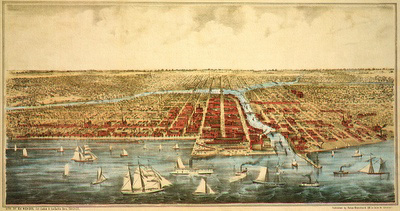
Chicago før bybrannen i 1871
In 1861 Niels H. Johannessen, the son of Postmaster Johannes of Slettnes emigrated together with six or seven other dissenters from Tromsø, Niels was a blacksmith. He settled in Chicago where he enlisted in the Union Army to serve in the Civil War. It was later said, at home in Norway that he had been killed in the war, but that doesn't seem to have been the case. Both he and his wife Sofia are found in the Chicago Census records of 1870 and 1880. However, it is possible that injuries suffered in the war eventually led to his death. At any rate, there were definitely other Norwegians already in Chicago for Bomstad and his followers to get help from. Of course there were also "agents" selling advice of questionable value to immigrants.
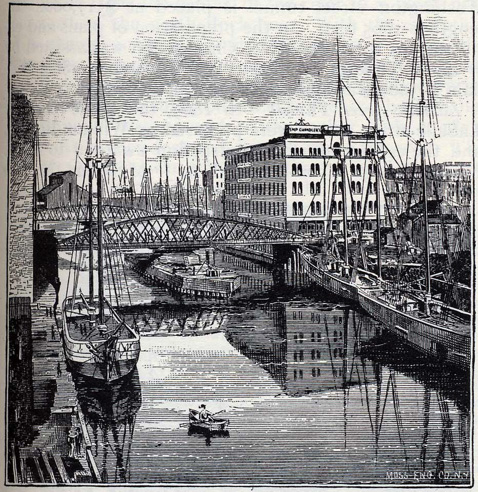
Chicago River, hvor Sleipner la til i 1862
In the course of the 1850's Chicago had developed into the commercial center and transportation hub of the American Midwest. It also was one of the largest American ports, connected to a vast agricultural area by both canals and the ever expanding railroad network. There was a great demand here for tradesmen, especially smiths and ironworkers.
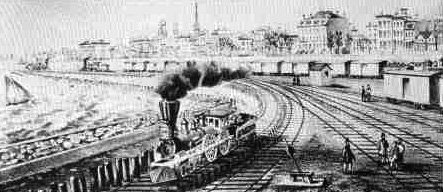
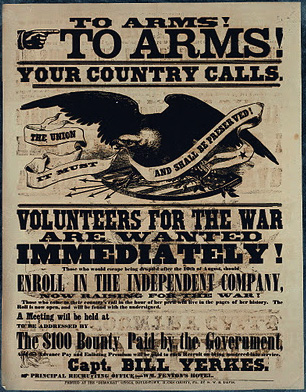
Verveplakat borgerkrigen
The immigrants had certainly heard rumors of the Civil War, but none could have imagined that it would turn out to be such a long and bloody war. Not even Abraham Lincoln could have known. And now, barely two weeks after their arrival, the Dakota Uprising broke out in Minnesota then at the western edge of European expansion. On August 17, a hunting party of young Indians from the Indian Reservation along the Minnesota River,captured and killed five settlers at Acton Minnesota some miles north of the river. Because of this development Bomstad's group could go no farther than Norseland near St. Peter 100 km (62 miles) southwest of Minneapolis, Minnesota. It was not far from New Ulm and Mankato, places known from the Indian Wars. St Peter was safer and more secure with military protection. Settlers in New Sweden township, just to the west of Norseland, built a stockade after some swedish farmers were killed on August 23 near Norwegian Grove. Fort Ridgely is 30 miles west of Norseland. We do not know where our Troms group was in those first dangerous days of the uprising but they were lucky that they did not arrive sooner.
In Chicago the immigrants were met with advertising signs and flyers encouraging the young men to enlist in the army. Many of the young Norwegians became soldiers. Some even lied about their ages to be accepted. They wanted to contribute to ending the war, so that their families could concentrate on their efforts to find land and establish themselves.
In the course of 1863 and 1864 several more families from Balsfjord arrived. Some acquired land and lived in the vicinity of St. Peter, but others, the restless ones, set out on "reconnaissance " to the west, following close to patrolling soldiers.
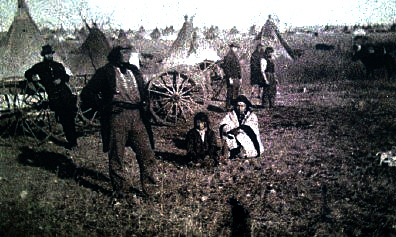
Soldater på vakt i en indianerleir
The young men from Troms became bored and restless from being confined to the military fort with nothing to do, so when the opportunity to sign up for military duty came they were quick to sign up. They were mostly assigned to the Indian Wars. One day three of them were on patrol in Kandiyohi County, and they came upon a beautiful, and as yet unsettled lake. J.A. J. Bomstad was notified, and set off on his grey mare with his rifle over his shoulder to investigate. He was pleased with what he saw. He and his followers would settle there when conditions allowed
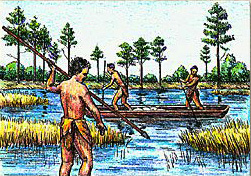
Kandiyohi County was known as a rich hunting area. Deer, wolves, bear, cougar, raccoon, muskrats, weasels, beaver, birds and water fowl (wild ducks and geese) were found there in abundance. The lakes and rivers were rich with fish. There was also some forest to provide wood for building and firewood to heat their homes. Plus, potentially rich farmland was available for those willing and able to do the hard work necessary to develop it, and enjoy this bounty. Farmers were encouraged to plant trees around their farm site,
The immigrants from Tromsø were far from the first to discover this. From the distant past this area was the hunting ground of the Dakota Indians. But, since the early 1800's white hunters and fur trappers had encroached here, looking for beaver skins, and buffalo. Following the hunters and trappers came fur buyers, and trading posts were established. Around 1850 came a flood of Europeans, and Scandinavians.

The Native American culture did not recognize individual property rights. These people saw themselves as Nature's protectors, whose duty was to protect the land and it's bounty. The settlers cut down the forests, and killed or frightened off the wildlife. The Indians were run off from the land which they felt it was their duty to preserve. The natives rejected European style agriculture, and suffered from lack of food when the animals disappeared. The trading posts often cheated the Native Americans and along with the government did little to help those in need.
This is the background for the Dakota uprising, which broke out in this area in August 1862. In Kandiyohi County, 13 settlers, and an unknown number of Indians were killed. The settlers gathered inside stockades for protection. The area was finally secured and declared safe in 1864.
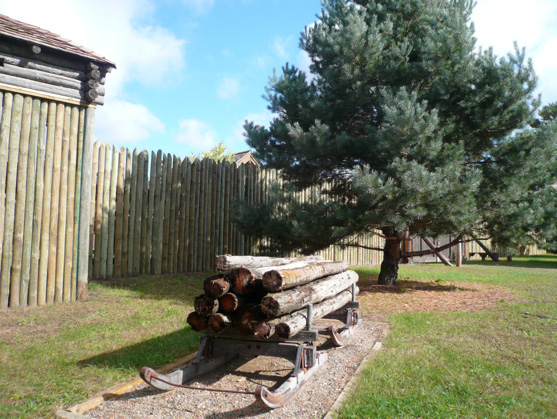
Rekonstruert stokkade i Forest City, Meeker - litt nord
for Kandiyohi. Bak stokkaden kunne det etterhvert
ligge en hel landsby. Eget foto 2013

There were several families along with the Bomstads that came to Lake Lillian that day in June 1864. Johan A. J. Bomstad himself (pictured above) and his wife Ane Brigitte Johansdatter had travelled with their seven children and a servant girl. Their sons Henrik and Johan Adolf were serving as soldiers and the oldest daughter was married during their stay in St. Peter. A list from the booklet “The First One Hundred Years” also gives us the names Sedevart Nelson, Elias Anderson and John Vick, but there could have been others in the party as well.
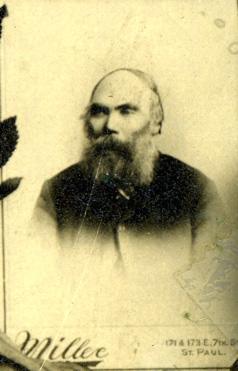
Sedevart Nilsen (pictured above) was unmarried when he set out with Bomstad in 1862. He was the son of Solvie Hansdatter and Nils Eliassen of Storsteinnes. Sedevart was highly respected by all, and soon took a leading role in the Lake Lillian community.
Elias Anderssen was from Tennes, Balsfjord. He and his wife Beate Lavine Hemmingsdatter came to America in 1863 with seven children and a foster child. Their oldest son Anders was known as Andrew (pictured below) was among the young men who enlisted. Elias had leased a farm near St. Peter, but went with those who traveled to Lake Lillian that June. He laid claim to a piece of land in East Lake Lillian, then returned to his leased farm to harvest and sell his crop. He brought his family to Lake Lillian in the fall.
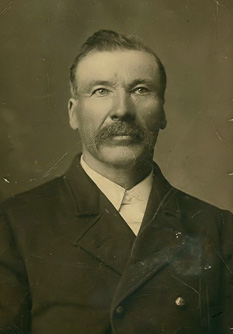
Husband and wife, Guttorm and Marith (Marit) Nilsen, and their two year old son Lars were from Breivik (Breivikeidet). They travelled from Norway in 1863. Once in the US, Guttorm had enlisted. He was eventually stationed at Fort Rice in North Dakota where he died in the spring of 1865, evidently from scurvy. The young widow (pictured below in her old age) took over the homestead in Lake Lillian in 1866, and several years later married William Lund from Lofoten.
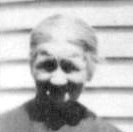
John Johnsen Vick (pictured below) was born in Åmot. At age 10 he and his parents moved north to Kvæfjord in Troms. He came to America in 1864 with his wife Anna Jacobi Danielsdatter and their three young children. John also took a leading role in the Lake Lillian community

In the beginning some settlers lived in "dugouts," (the one picture at the left was possibly in Montana), simple shelters half dug into a slope. The roof consisted of beams and planks covered with sod. A building method well known in the "Old Country." The interiors could be quite comfortable, and gave good protection from winter storms.
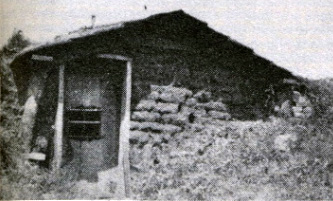
Later settlers began building simple log cabins, packing the joints with caulk and clay. The Bomstads moved into theirs in July 1864. (photo bflow). The layout of such pioneer houses was often very simple. One room at ground level, and a half loft above.
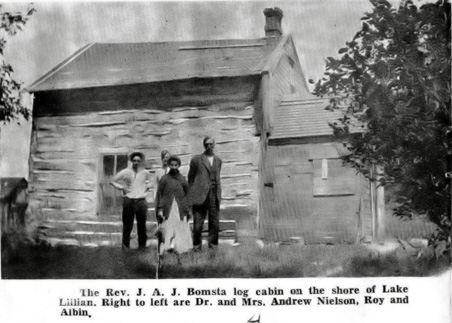
Elias Andersen and his family had moved into an abandoned shack left behind by some fur trappers.Later in the fall the shack burned. They rigged a roof between two haystacks and lived there for a while. They moved the cook stove outside for safety reasons and it was kept a good ways off. The cooking was done in wind, snow, and cold. Elias and his sons soon began building a log cabin, and the family was able to move in by Christmas. The hardships were a great strain for his wife, and her health failed. She died in 1865, the first pioneer woman to die in this new community.
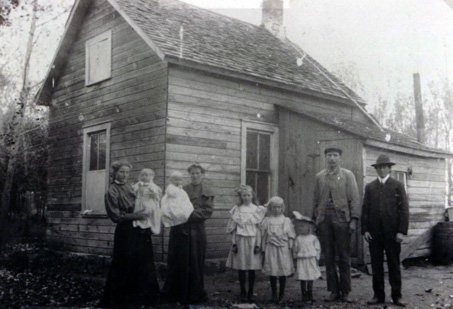
Later on milled lumber became available for building frame houses. Anton B. Hansen's house in East Lake Lillian section 15. (pictured above in 1906) was built with milled lumber framing, siding, and had a cedar shake roof. Still later many houses had covered porches and verandas as were proudly shown in photographs sent home to Norway. The house shown below belonged to Hans Peter Hansen from Balsfjord. It was in Section 17 just north of the town of Old Thorpe, and the picture was taken around 1900. The house is still there and is now lived in by a great grand daughter of Halfrida Sebulonsen. Frida came from Andersdal along the Balsfjord in 1900. *italic edits by Gary
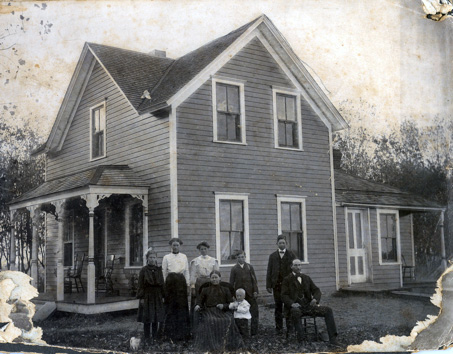
The pioneer settlements were divided into four townships. Lake Elizabeth, East Lake Lillian, Lake Lillian, and Fahlun. Of course, just as important as having a place to live in, was the need to provide food. The soil at Lake Lillian was among the richest in Minnesota. The Norwegian settlers were well prepared for the difficulties they faced in carving a livelihood out of the wilderness. Many of the men had valuable experience from their time spent at sea, or on the Arctic Ice, and were used to struggle and hardship. They set to work preparing the land and building farms. Lowlands and swampy areas were drained, and forest land was cleared for cultivation.

Innhøsting, East Lake Lillian
The early pioneers kept oxen, cows, chickens, and pigs plus horses to do the field work and provide transportation. They grew hay and wheat. Later came larger scale milk production, and corn, soybeans, sugar beets, peas and other vegetables were grown and harvested. Lake Lillian had one of the strongest farmers associations in Kandiyohi County. A creamery was built along with a sawmill and blacksmith's shop. (Usually the barn was built before the house because the care of their animals was so important to provide for their livelihood.)
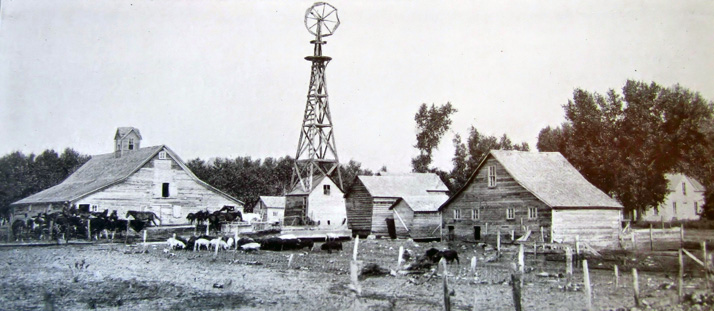
Hemming Andersons gård. Vanntårnet midt på bildet
In the early days Anders (Andrew) Anderson, Sedevart Nelson, and Lars P. Øwre would walk to St. Peter to buy salt, sugar, and molasses. They carried the supplies on their backs travelling 62 miles each way. However, soon there were shops in Lake Lillian that sold these essentials.
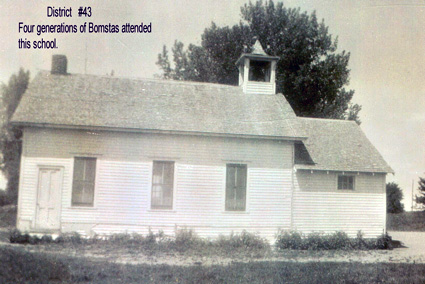
These people were very engaged in politics and social organizations. Much importance was given to cultural activities, and square dances were especially popular. Still, school and the life of the Church were of the greatest importance. School was held in Bomstad's log cabin until 1870 when the first schoolhouse was completed. Religious services were held in people's homes, then later in the schoolhouse. Four generations of Bomsta children attended classes in the schoolhouse shown in the picture above. (District 43)

Picture: J.A.J. Bomstad's grandson Adolf was born in the cabin near the barn. Both school and church services were held in such structures in the early days.

Indianere rundt 1900, illustrasjonsfoto
The Balsfjord Norwegians of Lake Lillian had generally good relations with the Native American people of the area. Even as late as the 1920's the Native Americans would come in their canoes to fish in Big Kandiyohi and Lake Lillian lakes. Still, some settlers feared the Indians. There is a story of a woman who would throw chairs and other things at groups of Indians, hoping to frighten them away. Other settlers kept an especially close eye on their children when there were Native Americans nearby. But, the main impression one gets by looking at materials gathered in 2014, is that our settlers learned to accommodate themselves to Indian customs, and learned much from them. One example is that they learned how to make rope from locally available materials. A Native American woman showed Elias Anderson how to soak and bend beech wood so he could make a hand reaper with teeth to do his harvest. At home in Norway the families from Balsfjord and Karlsøy had lived side by side with the migrating Sami, so they were used to interacting and trading with people who lived a completely different life than their own. This type of difference was not foreign to them.
LaVonne Bomsta Hookom, a descendant of Eliseus Bomsta and Elias Andersen (both dissenters from the State Church) believes that the desire for religious freedom was the greatest driving force behind the decision to emigrate. In America religious questions continued to be discussed. At home in Troms, they had been members of The Free Apostolic Church and had stood together against the power of the State Church. Now, in America several families broke off, and became active in the establishment of other churches and congregations such as The Lutheran Free Church, as well as Methodist and Baptist churches. Elias Andersen, his family and three others took the initiative to found The Scandinavian Methodist Episcopal Church in 1866. John J. Vick and Erik Larsen from Ullsfjord organized The Tromsø Lutheran Free Church. Many others became Baptists. Plus the strong appeal of buying cheap land in America would entice many to leave Norway.
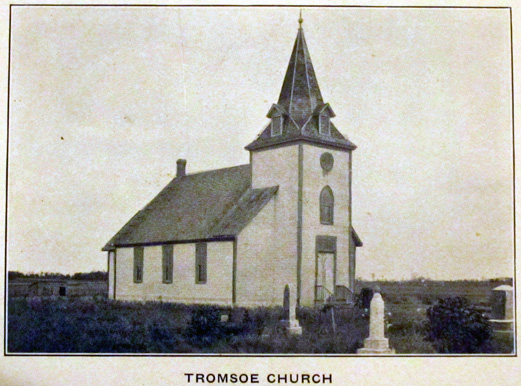
J.A.J. Bomstad's circle of followers diminished, but he remained active in church activities. He wrote several books including one in English. In 1870/71, and again in 1873 he returned to Norway and gave a series of lectures.
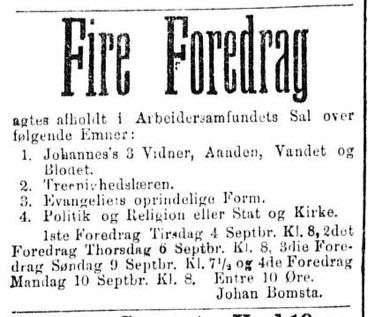
I found the announcement (above) in the Oslo newspaper Aftenposten from September 3, 1883. It reads:
Four Lectures to be given in the Worker's Society Hall, on the following subjects:
1) 2) 3) 4)
The three witnesses according to the Apostle John. The Spirit, The Water, and the Blood. The wisdom and teaching of the Holy Trinity. The original form of the Gospel. Politics and Religion, or State and Church.
First Lecture: Tuesday, September 4 at 8 pm Second Lecture: Thursday, September 6 at 8pm Third Lecture: Sunday, September 9 at 7:30pm Fourth Lecture: Monday, September 10 at 8pm
Admission: 10 øre Johan Bomsta
In the beginning the Bomstad family had tremendous influence in the settlement at Lake Lilian. Four of Bomstad's sons homesteaded there in the course of 1864 and 1865. His brother Albert Bomstad came following his military discharge, and a third brother, Eliseus Bomsta came to Lake Elizabeth Township with his son Esa and other children shortly afterward.
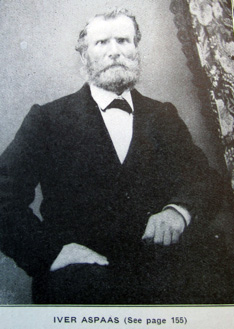
Other early settlers at Lake Lillian included Ivar Aspaas (pictured above), and his brother Jens Aspaas They were originally from Trondheim, but had lived many years in Tromsø. Together they had many years of experience as seal hunters and sailors. Hans Hansen Gaard, originally from Breivik, then later lived in Reinøya, had come to America in 1864 along with his brother Jens W. Hansen and their families. Jens drowned crossing the Mississippi River. The same night his wife Sara (pictured below) gave birth to their sixth child. Three years later she married Sedevart Nilsen.
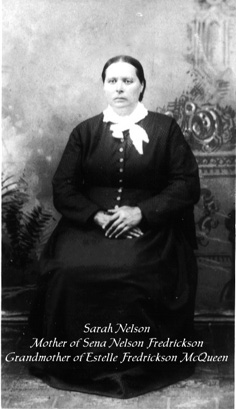
Nikolai Gabrielsen from Ramsfjord, Magdalena Hansen from Sjurnes, Nils Nilsen from Sandvær, and Erik J. Larsen from Breivik homesteaded in 1866 as did Thomas Thomassen from Signaldalen. In the United States he changed his name to Thomas Signal. I'm not sure whether he was a religious dissenter or not. However, other dissenters came later, I'll name only those from Balsfjord. Hans Hansen from Sandøra, and Gunder Halstensen from Balsfjord, although he was born in Åmot.
After 1866, there were new arrivals from Sweden, England, and Germany. Later on there was much intermarriage among the immigrant's descendants, and new family lines were established, thanks to their having come to America.
The settlement at Lake Lillian came to have great importance for later immigrants from Balsfjord and Karlsøy, although there were fewer of the latter. These newcomers put down roots not just in Lake Lillian, but in several small towns and villages in the surrounding area. Places like Atwater, Willmar, Litchfield, Appleton, and Artichoke.
Soon it wasn't just members from the dissenter congregations that came. In my own family there were several young women who made the long journey, often on their own. For a couple of generations they travelled to be with an older sister or aunt. The homes of their relatives or friends in the Lake Lillian area were their first stop in the New World. Here they would work as cooks, or household help, and have the time to orient themselves, and learn English.....to develop the skills to get by on their own. Many found husbands and remained in Minnesota. We see such stories well into the 1900's. Later immigrants were drawn to the West Coast, especially the state of Washington, and to British Columbia in Canada.

Trine Kaspersdatter Trangen (born 1894, and pictured above ) is a good representative of these young women. She set out from Øvergaard in 1906 to live with her aunt Martha Johnsen, in Atwater Minnesota. Trine was an excellent seamstress, and could easily support herself, so she soon set out westward. She lived for a while outside of Seattle, where her brother Ingvard Trangen, and his wife Jette had settled in 1908. Trine eventually married, and moved to Colorado where she owned and operated a mountain resort hotel for many years.
In the nineteen-fifties Lake Lillian was a busy place, with about 300 inhabitants. Farms had up to 24 milk cows, along with pigs and chickens. Besides wheat, oats, barley and alfalfa hay, they cultivated corn, soybeans, and sugar beets for sale. Later on sweet corn, cucumbers and peas were planted for Green Giant canning company.

Today there are far fewer, but larger farms. Only a few keep animals. Soybeans, corn, sugar beets and vegetables are grown for sale. Most shops and businesses, as well as the local schools are closed. Locally harvested agricultural products are sent out to Willmar and other larger towns. Children also attend school in these towns. The small country churches were torn down with the members merging with a larger congregation in town. Even the local Ford dealership (pictured above in1962), which also sold Ford tractors, has become a restaurant "The Food Garage". It is a popular spot with drivers, and other locals. If you go in for a cup of coffee you're sure to find an acquaintance to talk with.

I was there in 2013 along with the Tromsø Family and Local History Society. We received a warm hearted welcome! Many thanks to LaVonne Bomsta Hookom, and Gary Gauer who organized everything for us. Picture: The Main Street in Lake Lillian, photographed in October 2013. To the left can be seen the elevator, grain storage bins, water tower, and the "Food Garage
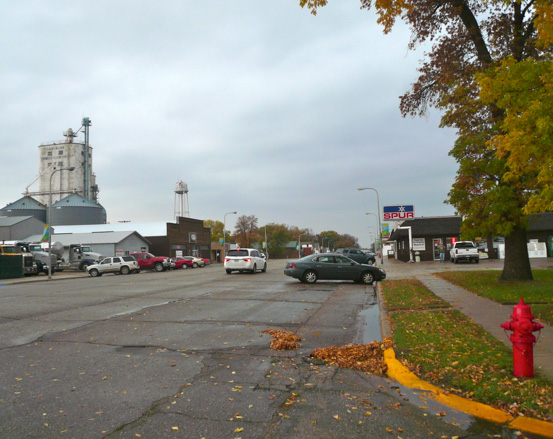
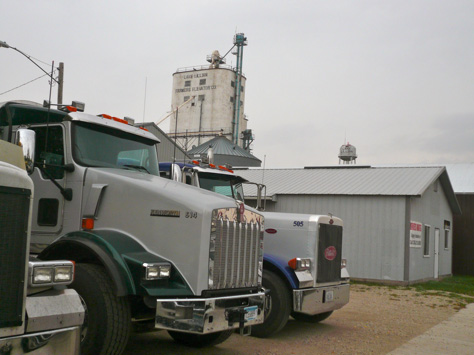
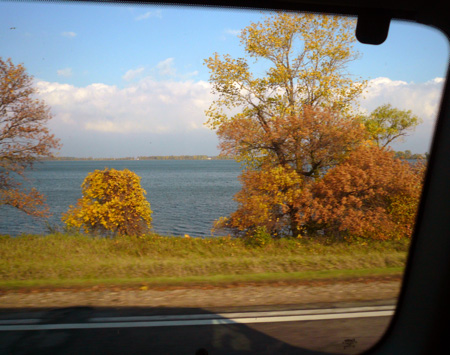
It was an emotional experience to walk through the cemeteries here. One finds so many familiar family names on the gravestones in the Tromsø Cemetery, Pioneers Union Cemetery, Baptist Cemetery, Scandinavian Methodist Episcopal Church Cemetery and others. There are so many stories! One must be filled with respect and admiration for the spirit of these pioneers, knowing the hardships they overcame so very far from their childhood homes.
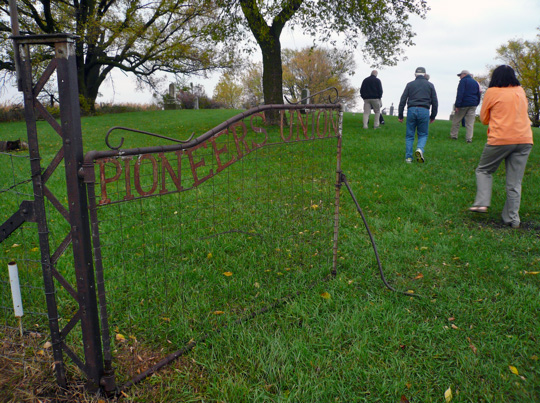
Large picture to right: Pioneers Union Cemetery Small picture: family researcher LaVonne Bomsta Hookom who has several of the Balsfjord/ Ullsfjord pioneers among her ancestors.

From Balsfjord and Malangen alone there may have been as many as 800, and perhaps up to 1,000 people who emigrated to America before 1930. An exact tally does not exist. The people in Lake Lillian had good relations with the Native Americans, but in the larger context our people were part of the wave of immigrants from Europe that cost the native people their land and resources, and which caused these people to suffer in ways that are painful to reflect upon. This type of migration and displacement has gone on throughout human history, and continues to this day. Is there a way for us to deal with this reality that respects everyone's fundamental human rights, and dignity, regardless of what group we belong to?
Tromsø January 4, 2015 Inger Giæver
Kilder:
«The First 100 Years - 1864-1964» - minnehefte om Lake Lillian 1964
Karl Jakob Skarstein: «Krigen mot siouxene» (Spartacus Forlag 2005)
P. Stiansen: «Baptistenes historie i Norge» (Oslo 1935)
Don Miller: «Kandiyohi Lakes area was once a ʻhunterʼs paradiseʼ» (artikkel 2011)
Håvard Dahl-Bratrein: «Bygdebok for Karlsøy og helgøy» (Tromsø 1989-94)
Internettressurser: Kirkebøker, dissenterprotokoller, Ancestry.com, NorwayHeritage.
Familiehistorier og bilder samlet inn av LaVonne Bomstad Hookom 2013-2014
Gary Gauers hjemmeside http://gauer001.net/~gauer001/fordgarg.html
Ikke minst bygger artikkelen på et ganske stort innsamlet materiale fra Amerika, ved LaVonne
B.Hookom i Willmar.
Opplysninger fra/korrespondanse med LaVonne, Gary Gauer, Kåre Strøm. Stor takk!
Se også Kaare Strøms hovedoppgave fra 2001: «Dei sjølvrådige. Ei dissentarrørslei eit fleiretnisk
samfunn, Balsfjorden i Troms» http://www.ub.uib.no/elpub/2001/h/506003/Hovedoppgave.pdf
Gamle bilder fra Lake Lillian og emigrantene dit er samlet av LaVonne.
Bildet av Ford-garasjen har jeg lånt fra Gary Gauers hjemmeside.
Fargebilder fra 2013 er tatt av meg.
Bildet av Trine Trangen er utsnitt av et større, fra facebooksida «Gamle Balsfjord og Malangen»
Bilder av indianere og Chicago er tjuvlån fa internett!
Med mindre endringer (og færre bilder!) har artikkelen stått på trykk i Årbok for Balsfjord og
Malangen 2014. Se også Kåre Strøms artikler i samme årbok.
